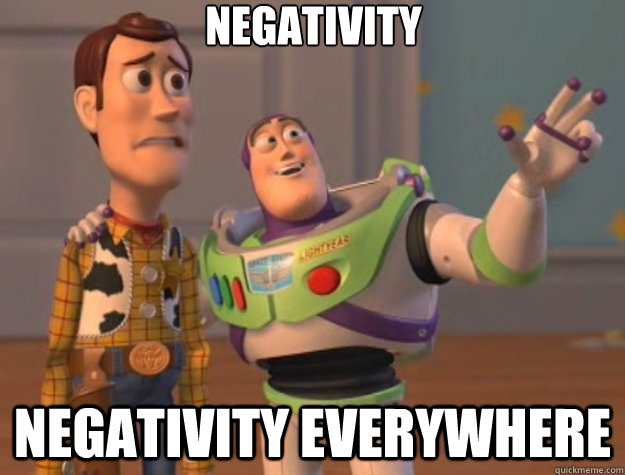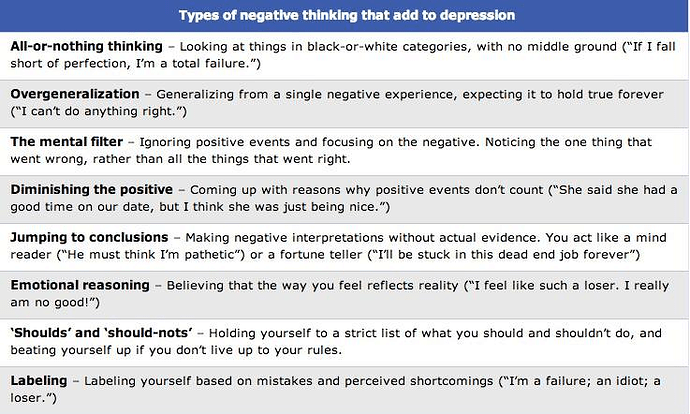
Everyone gets stuck in a negative thought loop at some point in time. But if don’t know how to deal with it, getting stuck in negative thoughts can be debilitating and distressing and it can prevent us from moving forward with our life. Learn four ways you make the shift to a positive and balanced mindset. (Estimated reading time: 5-6 minutes)
“You can’t stop negative thoughts from coming but you can choose to not let them take root.”
— Joel Osteen
All of us have experienced what it’s like to be stuck in negative thoughts. Whether it was an offhand comment made by someone close to you, or a specific event, it instigated the storm of negative thoughts, you were left feeling depleted and drained once it dissipated.
Our triggers are subjective and personal to each of us. They depend on our upbringing and how we cope with perceived challenges. There is one common denominator – a fear that our security and desires are at stake.
Dark clouds of doom and gloom envelope our psyche, and we quickly lose sight of what’s real and what’s not. “I’m not good enough.” “What if this plan messes up?” “What if they think I’m a quack?” “Maybe air travel is not so safe after all.” These thoughts remind us of our flaws and fabricate narratives that cause us unnecessary worry.
The only way to clear out this fog of doubt is to shine a light on our thought patterns. Understand that we are ‘thinking animals’, biologically programmed to fix what we don’t like. It’s a mechanism that’s coded in our DNA to ensure our safety and survival. But when our concerns are taken too far, it can ruin our quality of life.

The human inclination to overthink is compounded by other influences such as genetics, and the environment we grew up in. When it comes to genetic makeup, some people are ‘Eeyores,’ naturally prone to focusing on the negative, while some are ‘Tiggers’, who search for the good in every situation. Most people fall somewhere in the middle.
Our environment and the people around us also have a significant impact on the way we think. When we were kids, we internalized whatever our parents showed us through their parenting style. If they were prone to bouts of worry and anxiety, we most definitely picked up on that. Even as adults, we might be influenced by negative media, our co-workers, and friends.
Regardless of where we stand in the continuum of negativity, all of us are vulnerable to being caught up in negative thinking spirals. We must be aware when this happens, and take necessary measures to stop it. The first critical step is to figure out the type of negative thought patterns we’re experiencing. These are eight of the most common ones:

Image credit: https://family.schizophrenia.com/
Your mind might trick you into believing that being negative is a safety measure that’ll protect you from having your hopes dashed. Like a lot of people, you might mistake negative thinking for ‘being realistic’. Even though your mind might trick you into believing this, your body will never lie. You’ll experience stress-related symptoms like headaches, body aches, frequent illness, decreased energy, and insomnia.
It’s hard for many people to pick up on this. We live in an overmedicated society where people try numbing these symptoms. Instead of dealing with the root cause of their pain they numb it with pills and escapism. Not only does this set up a toxic pattern of substance dependency, but it robs them of the opportunity to grow and learn from their experiences.
In some cases, deeply entrenched depression and trauma will need the supervision of qualified mental health professionals, but most people can overcome their negative thoughts with some discipline and effort.
Just like eating junk food and biting nails, negative thinking is a bad habit that we can control by setting up structures to maintain peace in our mental space.
Here are four things you can do if you ever find yourself stuck in negative thoughts:
1. Examine your history and treat deep rooted issues: Our beliefs and thinking patterns were established in our childhood. Your mental processes can shift as you mature, depending on how self-aware you are, and the amount of effort you put into restructuring your thoughts. However, you can be sure that your early beginnings play a dominant role in determining your response to events on a subconscious level. Reflect on your history and the possible origins of your negativity by writing in a journal, or working with a therapist. Ask yourself: Where did this pattern originate? Was there a particular event or person that triggered it?
2. Monitor your thoughts: After reflecting on the past, you can bring your attention back to the present. Your analysis offers the context that you need to put your current circumstances into perspective. This will make it easier to evaluate your reactions objectively. Like a fly on the wall, observe your thoughts, paying particular attention to the people and circumstances that trigger your negativity. Make notes on your thoughts and moods throughout the day, without making any judgments. Through this exercise, you’ll realize the futility of these erroneous thoughts.
3. Have a ‘negativity zapper’ toolbox: There are plenty of mental, emotional, and physical modalities that you can use to keep your negative thoughts in check. A healthy lifestyle will ensure that your physiological state is on an even keel. Emotions can be balanced through techniques such as EFT, tapping, journaling, therapy, meditation, and several others. On a mind level, you can stay conscious of the quality of your thoughts and your interpretation of events. One of my favorite techniques is ‘reframing’ a situation – strive to see things from different perspectives.
For example, if you get stuck in a traffic jam, instead of getting frustrated about the delays, view it as an opportunity to unplug and relax while you wait instead. Find a combination of tools that work best for you and your personality type.
4. Search for the kernel of wisdom: Negative thinking is an exaggerated outlook. Although this mindset can blow things out proportion, if we scale back the fear and drama, we’ll see that there is a kernel of wisdom and insight from which we can benefit. When you’re no longer panicking, you can view your concerns through a fresh lens of practicality. Instead of letting your emotions snowball, you can take calculated steps to put yourself in a position of power and strength.
For example, let’s say you’re concerned about losing your job because your company lost a big client. Instead of allowing this possibility to scare you, become proactive getting more information based on facts and data, rather than rumors. You can also take this as a push to search for other opportunities that will offer more job security.
Cartoonist Bill Keane once said that our mind is like water – when it is agitated, it becomes difficult to see. But if you allow it to settle, the answers become clear. So, the next time that you’re feeling bleak do your best to dispel the murky thoughts of fear from the tranquility of your inner world, and make room for abundance and love to flow in.
All my best on your journey,
Seline

Reflection Question: How often do you find yourself stuck in a negative thoughts? What do you usually do when this happens?
Did you like this post? Sign up below, and I’ll send you more awesome posts like this every week.

Have Your Say